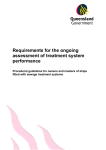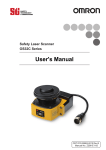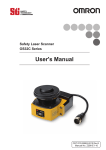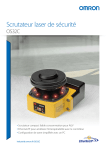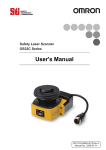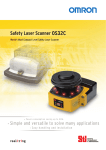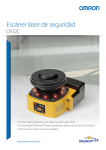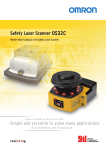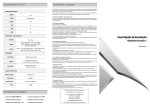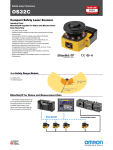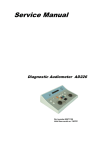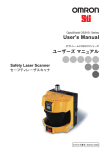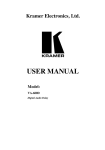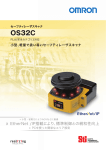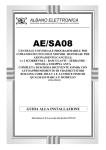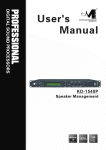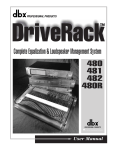Download Quick Reference Guide
Transcript
To ensure a protection degree of IP65, DO NOT use this product without proper sealing of the cable connector, I/O block, and scan window. If the external zone switching device momentarily exceeds the configured number of active zone set select inputs during the zone switch, an additional Zone Delay may be incurred in the event that wiring of a zone set select input fails. The external zone switching device must properly sequence so the configured number of active inputs is not exceeded in order to guarantee that failed zone set select input wiring will be detected within the normal Zone Switching Time. OS32C Safety Laser Scanner Quick Reference Guide OS32C Dimensions Model (OS32C-BP) shown Ethernet cable not shown Ethernet connector with M12 cap plug (cable not shown) If an insufficient Zone Delay is used for the actual worst case switching time of the installation, the scanner might start monitoring the wrong zone during the switching period. Also, if an insufficient Zone Delay is used for the actual worst case switching time of the installation, there might be a fault condition during the zone switching period. 158.3 [6.24] Dust Detection Safety Precautions Indicates a potentially hazardous situation which, if not avoided, will result in minor or moderate injury, or may result in serious injury or death. Additionally there may be significant property damage. Indicates a potentially hazardous situation which, if not avoided, will result in minor or moderate injury, or there may be property damage. Meaning of alert Symbols Indicates prohibited actions. Indicates mandatory actions. If more information is needed, refer to the OS32C user’s manual (Z296-E1-07). Alert Statements in this Manual An OS32C is an electro-sensitive protective equipment designed to guard personnel working around hazardous machinery. Whether a specific machine application and the OS32C system installation complies with safety regulations depends on the proper application, installation, maintenance and operation of the OS32C system. These items are the responsibility of the purchaser, installer and user. User The administrator is responsible for the selection and training of personnel to properly install, operate, and maintain the machine and its safeguarding systems. An OS32C system should only be installed, verified and maintained by a qualified person. A qualified person is defined as ”an individual who understands, is trained on, and demonstrates competence with the construction, operation or maintenance of the machinery and the hazards involved.” (ANSI/PMMI B155.1- 2006) The machine requirements 104.3 [4.11] Top view Monitoring zone parameters are subject to a number of constraints that include projective consistency, maximum radius, and angle limits. As a result, an imported zone may not correspond exactly to the zone defined in the file. The user must visually verify the imported zone when the zone coordinate import process is complete. Refer to Checkout and Test Procedure Log in the OS32C user's manual. If there is any damage to the window, replace it as soon as possible. Otherwise it may result in a failure of the OS32C. Take preventive measures when performing replacement work so that dust does not enter the OS32C. The test outlined in this test procedure (See “Checkout and Test Procedure Log” in the OS32C user's manual) must be performed at time of installation, according to the employer’s regular inspection program and after any maintenance, tooling change, set up, adjustment, or modification to the OS32C system or the guarded machine. Where a guarded machine is used by multiple operators or shifts, it is suggested that the test procedure be performed at each shift or operation change and also if there is a change in the OS32C operating mode or defined zone sets. Testing ensures that the safety laser scanner and the machine control system are working properly to stop the machine. Failure to test properly could result in serious injury to personnel. If the OS32C is operated under automatic start, make sure that the machine stops and does not restart as long as an object is detected in a safety zone. Check the operation by placing a test piece into the safety zone. It is recommended to perform the test at least after a shift change or 24 hours of operation. If the safety system or the machine fails any of these tests, do not run the machine. Immediately tag or lock out the machine to prevent its use and notify the appropriate supervisor. This laser scanner may not be sold or imported into, or used in, the Federal Republic of Germany prior to December 1, 2013. System and zone status parameters monitored over EtherNet/IP are to be used for diagnostic purposes only, and must not be used in safety-critical functions. Back view 142.7 [5.62] Ethernet connector with M12 cap plug (cable not shown) 102.9 [4.05] Back plate I/O cable assy for OS32C-BP 88.1[3.47] 2.0, 3.0, 10.0, 20.0 or 30.0 meters 30.0 [1.18]OD 71.3 [2.81] (min) Ethernet cable 5° or more I/O cable 5° or more 270 (10.63) Bottom view DIMENSIONS: mm [inches] Rating/Performance Sensor Type Safety Category Type 3 Safety Laser Scanner Category 3, Performance Level d (ISO13849-1: 2008) Functional Safety of Electrical/Electronic/ Programmable Electronic Safety-related Systems SIL 2 (IEC61508) Detection Capability Monitoring Zone Configurable; Non-transparent with a diameter of 30, 40, 50, 70mm (1.8% reflectivity or greater) Monitoring Zone Set Count (Safety Zone + 2 Warning Zones) : 70 sets max. Maximum Measurement Error Detection Angle Angular Resolution Laser Beam Diameter 100mm *1 270° 0.4 degree 6mm at optics cover, 14mm (typical) at 3m. When transferring data from the PC to the OS32C and more than one OS32C is connected to the network, it is necessary to visually check the diagnostic code on the status/diagnostic display. It is recommended that the OS32C be installed in a position where the status/diagnostic display will be visible. Laser Scan Plane Height Response Time Take precautions to prevent dirt, dust or debris from entering the sensor and I/O block connectors. It is recommended that this be done on a clean workstation as contaminants may degrade the performance of the OS32C. Zone Switching Time Line voltage Power Consumption Adhesion of dust to the scan window may cause a false operation. The OS32C will require periodic cleaning of the scan window and dust detection surface. 67mm from the bottom of the scanner (see "OS32C Dimensions" above for more detail) Response time from ON --> OFF: From 80 ms (2 scans) to 680ms (up to 17 scans) Response time from OFF --> ON: Configurable. From 20 to 320ms 24VDC +25%/-30% (ripple p-p 2.5V max.) *2 Normal operation: 5Wmax., 4W typical (without output load)*3 Standby mode: 3.75W (without output load) Emission Source (Wavelength) Infrared Laser Diode (905nm) Operation of the OS32C may be affected by light in the environment, such as incandescent light, strobe light and light from a photosensor using infrared light. Laser Protection Class Operation of the OS32C may be affected by substances in the environment, such as fog, smoke, steam and other small particles. Safety Output (OSSD) Class 1 : IEC/EN60825-1(2007) Class 1 : JIS 6802(2005) Class I : CFR21 1040.10, 1040.11 PNP transistor x 2, load current of 250mA max., residual voltage of 2V max., load capacitance of 2.2 μf max., leak current of 1mA max *3, *4, *5. Auxiliary Output (Non-Safety) Warning Output (Non-Safety) System Components (10) (9) (11) (8) (7) (6) Operation Mode External Device Monitoring Start Input Zone Select Standby Connection Type Connection with PC Indicators The main unit must be securely mounted and its cable connectors must be tightly attached. (12) (13) (1) (2) No. (3) (4) (5) Function Component (1) RUN output indicator (green) (2) Interlock Indicator (yellow) Will turn ON when safety zone is clear and OSSDs are ON. Will turn ON when in interlock state, blink under lockout, and blink in case of a failure. (3) Status/Diagnostic Display (4) Warning Output Indicator (orange) (5) STOP output indicator (red) The scanner's status ,configuration/operation, or failure is displayed Will turn ON when the warning output is ON. Will turn ON when safety zone is blocked, OSSD are OFF or under interlock state. Configuring Multiple OS32C Scanners The possibility exists that two OS32C may interfere with each other. To avoid this when using multiple OS32C in the same location, please review the following mounting recommendations. Adjust the scanners to offset the scanning plane by tilting the OS32Cs. Adjust the scanners to offset the scanning plane by mounting the OS32Cs at different heights. Adjust the scanners to different scanning planes and additional sampling scans (response time) on the OS32Cs. Install a barrier to block the direct path of possible signal crossing. Offset Scanning Level by Tilting Detection Plane 5°or more 5°or more Offset Parallel Scanning Levels by Different Installation Height Detection Plane NPN/PNP transistor x 1, load current of 100mA max., residual voltage of 2V max., leak current of 1mA max *4, 5, 7 NPN/PNP transistor x 1, load current of 100mA max.,residual voltage of 2V max., leak current of 1mA max *4, 5, 7 Auto Start, Start Interlock, Start/Restart Interlock ON: 0V short (input current of 50mA), OFF: Open 5°or more ON: 0V short (input current of 20mA), OFF: Open ON: 24V short (input current of 5mA), OFF: Open ON: 24V short (input current of 5mA max.), OFF: Open Power Cable: 18-pin mini-connector (pigtail) Communication Cable: M12, 4-pin connector Communication: Ethernet *6 OS Supported: Windows 2000, Windows XP, Windows Vista, Windows 7 Detection Plane RUN Indicator : Green, STOP Indicator : Red, Interlock Indicator : Yellow, Warning/Auxiliary Output Indicator : Orange Status/Diagnostic Display: 2 x 7-segment LEDs Individual Sector Indicators: Red LED x 8 Protective Circuit Protection against output load short and reverse power connection Ambient Temperature Ambient Humidity Ambient Operation Illumination Insulation resistance Dielectric withstand voltage Enclosure Rating Enclosure Operation: -10 to 50 deg. C, Storage: -25 to 70 deg. C Operation & Storage: 95%RH max., non-condensing Incandescent lamp: Illumination on receiving surface 1500lx max. (an angle of laser scanning plane and disturbance light must be +/-5 degrees or more) 20Mega-ohm or higher (500VDC) 350VAC, 50/60Hz, 1 minute IP65(IEC60529) Sensor Head: Die-cast aluminum Optics Cover: Polycarbonate I/O Block: Die-cast aluminum (6) Dust Ring Dust detection cover with reflective surface, for dust accumulation detection Dimensions (WxHxD) 133.0 x 104.5 x 142.7mm (except cable) (7) Individual Sector Indicators Impact Resistance 98m/s 2 1000 times for each of X, Y, and Z directions (IEC60068-2-29) (8) Scan Window Will turn ON when an intrusion is detected in the safety zone, 8 sectors total. Each sector = 33.75°. The window where the laser light is emitted and received. Vibration (9) Communication Connector Provides for Ethernet interface.*1 10~55Hz double-amplitude of 0.7mm, 20 sweepings for X, Y, and Z directions (IEC60068-2-6) If the response time is changed, re-calculation of the safety distance is required. This may require re-configuration of the safety zones or re-installation of the OS32C. If the safety distance is not appropriate for the application, the machine may not stop before contact with the hazardous part, resulting in serious injuries or death. (10) Power Connector For power connections, 18-pin connector (pigtail). *1 Weight (Main Unit only) 1.3kg (11) I/O Block Connector module Power Cable Up to 30m (12) Center of Rotation Indicates the location of the axis around which the laser irradiates from. Communication Cable Up to 100m for 100 BASE-T Cat 5 cable When using more than one OS32C, mutual interference should be prevented. This may require different scanner positions or physical shields to be installed. (13) Sensor Sensor Head; field replaceable. Approvals Certificated by: TÜV Rheinland, UL Major Standards: IEC61496-1/-3 Type 3, ISO13849-1:2008 Category 3, UL508, UL1998 *1: The communication and power connections can also be mounted on the left side of the I/O block. The following considerations should be taken into account when determining the mounting location for the OS32C. It is possible for ambient light to interfere with normal operation of the OS32C. Ambient light interference DOES NOT lead to a loss of safety, it may, however, cause false nuisance stops of the guarded equipment. Some installations may require that the OS32C be mounted in direct exposure to ambient light. In these situations you must assure that the separation between the scan plane of the OS32C and the light source be greater than +/-5°. Controller cable assy Safety Zone : 1.75m (30mm res.), 2.5m (40mm res.), 3.0m (50mm or 70mm res.) Warning Zone : 10.0m Installation To use the protective function of the OS32C, a safety zone must be properly defined and configured. 50.9 [2.01] Operating Range Do not use the auxiliary output or warning output for safety applications. A human body may not be detected even if a failure of OS32C occurs, resulting in serious injuries. Additional measurement error resulting from reflective backgrounds may need to be added to the measurement error of the OS32C Side view Measurement data monitored over EtherNet/IP are to be used for diagnostic purposes only, and must not be used in safety-critical functions. All safety-related machine control elements must be designed so that an alarm in the control logic or failure of the control circuit does not lead to a failure to danger. Perform only the test and repair procedures outlined in the OS32C user's manual. Operation of the OS32C may be affected by substances in the environment, such as fog, smoke, steam and other small particles. 67.0 [2.64] Scan plane 71.5 [2.82] The guarded machine must have a consistent stopping time and adequate control mechanisms. Perform the test procedure described in the OS32C user's manual at installation, after maintenance, adjustment, repair or modification to the machine controls, tooling or the OS32C system. 32.8 [1.29] Front view 121.0 [4.77] Mtg holes Always detach all cables from the OS32C before replacing the scan window. Otherwise the motor may start rotating, resulting in injuries. Ensure the measurement report configuration matches the expected measurement data format. Additional guarding may be required to prohibit access to dangerous areas not covered by the OS32C system. 6.0 [0.24] Operation of the OS32C may be affected by light in the environment, such as incandescent light, strobe light and light from a photosensor using infrared light. 104.5 [4.12] 41.4 [1.63] Mtg holes 27.7 [1.09] Mounting Considerations 140.4 [5.53] M5x0.8 (x4) 57.0 [2.25] *4. Output voltage is Input voltage - 2.0VDC. *5. Total consumption current of 2 OSSDs, auxiliary output, and warning output must not exceed 700mA. *6. An ethernet cable with an M12, 4-pin connector is required. *7. Output polarity (NPN/PNP) is configurable via the configuration tool. 100.0 [3.94] 133.0 [5.24] Do not modify the main unit of the OS32C. Do not replace or fix any component of the OS32C other than the ones specified in the user's manual. Doing so may result in a failure of the device to function correctly. The guarded machine must be able to stop anywhere in its cycle. Do not use an OS32C on a press with a full-revolution clutch. A start switch to release interlock must be installed where an operator can observe the monitored/guarded zone as a whole and cannot operate the switch within the hazardous zone. A protective mechanism must be installed to prevent a hazardous condition in the event of a subsequent machine component failure. The OS32C does not protect against ejected flying material. Severe smoke and particulate matter may degrade the efficiency of an OS32C, causing it to unexpectedly enter a Machine Stop state. Use of mirrors or mirror-like objects in the protection plane must be avoided, as they can hide part of the area to be monitored/guarded. I/O block Sensor head Isometric view 50.0 [1.97] The Alert symbols and their meanings ensure safe use of the products. In order to use the OS32C safely, the precautions listed in this manual are indicated by alert symbols. The descriptions must be followed, failure to follow all precautions and alerts may result in an unsafe installation or operation. The following indications and symbols are used. Window If tstart (switching start time) is configured without consideration of TmaxReaction (total maximum reaction time), object detection within the new safety zone after switching and turning OFF of the safety outputs may be delayed. Others © OMRON Corporation 2013 All Rights Reserved. I/O cable 90.4 [3.56] *1. An additional measurement error may need to be added due to reflective backgrounds (See user's manual for details). *2. For power source specification, see Power Supply Unit in the OS32C user's manual. *3. Rated current of OS32C is 1.025A max. (OS32C 210mA + OSSD A load + OSSD B load + Auxiliary output load + Warning output load + Functional Inputs). Where functional inputs are: EDM input ... 50mA Start input ... 20mA Standby input ... 5mA Zone X input ... 5mA x 8 (eight zone set select inputs) 5°or more When installing the OS32Cs side by side, it is more effective to set their mounting heights differently. When adjusting the OS32C tilted, it may be more effective to adjust the OS32C downward depending on the condition of the outside light source (natural light or halogen light). Separation using a screen Screen Front View Top View Use of a screen may increase the effect of reflection depending on its material. Select one with matte black finish that is resistant to reflection. Stationary Installation Mobile Installation for Automated Guided Vehicles (AGV) Safety Distance (Required Depth of Safety Zone) Always configure the safety zone in such a way that the machine comes to a standstill in a time less than that taken to reach the danger point of the machine after infringing (interrupting) the safety zone. The standard ISO 13855-2005 (EN 999-1998) must be used to calculate the minimum safety distance; according to ISO 13855-2005 (EN 999-1998), the minimum safety distance, S, from the danger zone area to the outer edge of the safety zone is calculated as follows: S = (K x T) + C + Z where: S = Minimum safety distance in mm measured from the danger area to the outer contour of the safety zone. K = Movement or approach speed in mm/s (constant K = 1600 mm/s) T = Delay between interruption of the safety zone and standstill of the machine in seconds consisting of the sum of t1, t2 and t3: t1 = Response time of the OS32C t2 = Rundown time of the machine (mechanical rundown, reaction time of control system) t3 = additional time delay for use when multiple zones are used (t3 = 10 ms.) C = Safety constant with C = 1200 mm - 0.4 x H (C≥ 850); where H = Distance of detection level from reference level in mm Z = Additional safety factors (maximum measurement error) (Z = Z1 + Z2) Z1 = The OS32C's maximum measurement error (100 mm) Z2 = Additional error by reflective background Refer to the OS32C user's manual for aditional Error by Reflective Background. For calculating the minimum safety distance for AGV, the standard IEC 61496-3 can be used. The safety distance, S, for use with an AGV should be calculated using the following formula: S = Minimum safety distance in mm measured from the danger area to the outer contour of the safety zone. SP = Maximum stopping distance for AGV (mm) Z = Additional safety factors (maximum measurement error) With the conditions above, the minimum safety distance S is calculated as follows: S = SP+ Z SP = (Vmax. x T) + Sbrake Z = Z1+ Z2+ Zgc+ Zbf Vmax= Maximum speed of AGV in mm/s T = Response time consisting of sum of t1, t2 and t3: t1= Response time of OS32C t2= Response time of AGV t3 = additional time delay for use when multiple zones are used (t3 = 10 ms.) Sbrake = Braking distance of AGV in mm based on manufacturer's document Z1 = OS32C's measurement error (100mm) Z2 = Additional error by reflective background ( Refer to OS32C user's manual - Additional Error due to Reflective Background) Zgc = Safety factor for lack of clearance between under surface of AGV and ground. See figure below. Zbf = Safe factor for reduction of brake force of the AGV through wear and usage. Safety Factor for Low Ground Clearance Documentation of Configuration Parameters Configured zone The person responsible for the set-up must record the configuration parameters, print out and sign the report. Connect the printer to the PC. Select the menu "File/Print Configuration" in the configuration software. The report is printed out. Sign and date the report and file it in a known location which is always accessible. AGV Safety factor Stationary Installation Example Do not connect the OS32C to a power supply with more than 24VDC + 25% / -30%. Do not supply AC power to the OS32C, this may result in electrical shock. Status Normal Operation For the OS32C to meet IEC 61496-1 and UL 508, its DC power supply unit must satisfy all of the following conditions: Within rated line voltage (24 VDC +25% / -30%) Complying with EMC directives (industrial environments) Double-insulation or reinforced insulation between primary and secondary circuits Automatic return for overcurrent protection Output retention time of 20 ms or longer Satisfying output characteristics requirements of Class 2 circuit or limited voltage/current circuit defined in UL508. Power supply complying with regulations and standards of EMC and safety country or a region where OS32C is used. (Example of electrical equipment in EU, a power supply must comply with EMC directives for low-voltage) To prevent electrical shock, use double-insulation or reinforced insulation from hazardous voltage (such as 230 VAC). 50 0 100 50 Safety factor Zgc (mm) 150 To use this product for a category 3 safety system, both safety outputs must be connected to the safety system. Configuring a safety system with only one safety output may result in serious injuries due to output circuit fault and a failure of the machine to stop. Safety output fault External device monitoring fault Signal Connector Isolation: The connectors used during installation must provide sufficient signal separation in order to prevent a short circuit condition of the input power and system signals. Safety Distance (Width Required for Safety Zone) Other fault Basic connection (with single OS32C unit) Category 3, Performance Level d(ISO13849-1) E1 SW = VW + 2 x Z PE 0V Functional Earth (Green) Testing the Safety Area +24V 24VDC (White) If the OS32C is operating in automatic start mode, make sure that the machine stops and not restart when the test object is in the safety zone. Check its operation by approach of a test object into a safety zone. It is recommended that this test be performed after a shift change or 24 hours of operation. H = 300 mm Side View The OS32C measurement error Z1 (100 mm) Additional error Z2 by reflective background (In this example, Z2 is 0 due to no surrounding wall. See user's manual). Machine table Width of danger zone Danger zone Testing a Horizontal Safety Zone Z Safety zone distance M Top view Cover to prevent intrusion to dead zone 1m 2m STOP SFdistance OS32C START Note: In this example, a semicircle is configured as 2m of safety zone and 3m of warning zone. Specifications K = 1600mm/s: Movement or approach speed (mm/s) T = t1 + t2 t1 = 0.08s: Response time of OS32C (s) t2 = 0.2s: Stop time including response time of machine (s) C = 1200mm - 0.4xH (C ≥ 850mm): safety factor (mm) H= 300mm: Distance of detected level from reference level (mm) Z = Z1+ Z2 Z1 = 100mm: OS32C's measurement error (mm) Z2 = 0mm: Additional error by reflective background (mm) Warning Zone If the OS32C fails any of these tests, lock out the guarded equipment and contact the factory supervisor immediately. -- Normal operation (guarded machine stop) - - - blinking at a slow rate Standby mode (guarded machine stop). The rate of blinking depends on the mode. - 01 Interlock state (waiting for start input) 02 Configuration mode (guarded machine stop) - 80 Window contamination indication (guarded machine stop) The window is dirty or scratched, clean or replace as necessary 70 Incorrect number of active zone inputs (guarded machine stop) Check zone set select input wiring, zone configuration selection, zone set select input switching time and zone delay configuration 71 Invalid or undefined zone input combination but correct number of active zone inputs (guarded machine stop) Check zone set select input wiring, zone configuration selection, zone set select input switching time and zone delay configuration 30 Refer to Status/Diagnostic Display Indication of the OS32C user's manual Safety output fault 32 Safety output A is short-circuited to 24V 33 Safety output B is short-circuited to 24V 34 Safety output A is short-circuited to 0V 35 Safety output B is short-circuited to 0V Check output connection and wiring 40 EDM (external device monitoring) fault Check output external device monitoring connection and wiring. 41 External device monitoring fault before OSSD turning ON Check the NC-contact status of the external device is changing state before the OSSDs turning ON. 42 External device monitoring fault after OSSD turning ON Check the NC-contact status of the external device is changing state after the OSSDs turning ON. 43 External device monitoring fault during OS32C power on Check the OS32Cs output configuration,connections and wiring. If window was just replaced, perform window calibration. Check the environment if any noise or disturbance light is coming in. Or consult factory. 50 Affected by noise or disturbance light. Or internal fault. 51 Mutual interference 52 Possible electrical noise interference or internal fault. Check the environment for electrical noise sources or repair the unit. Or consult factory. Mounting Considerations of the OS2C user's manual 55 S3 Standby input (Violet) 56 *4 S2 *4 S2 57 Zone Select 3 (Gray) *4 S2 58 Zone Select 4 (Pink) *4 *4 S2 S2 59 Zone Select 5 (White/Black) The unit was possibly jarred or bumped. Check the environment if any jarring or bumping occurs. 60 Invalid configuration in unit Reconfigure unit or double check current configuration. 72 Incorrect number of active zone inputs Check zone set select input wiring (hard fault code after diagnostic code 70 and zone configuration selection. above persists for more than 10 minutes) 73 Invalid or undefined zone set select input Check zone set select input wiring combination, but correct number of active and zone configuration selection. zone set select inputs.(hard fault code after diagnostic code 71 persists for more than 10 minutes) Zone Select 6 (Tan) *4 Zone Select 7 (Orange) *4 Zone Select 8 (Blue/White) Start (Black) *4 *3 S2 S2 S2 S1 Auxiliary output(Blue) ED1 ED2 Warning output (Red/Black) * 2 Safety output B (Yellow) Safety output A (Red) ED1 *1 *1 OS32C Configuration - External Device Monitoring Enabled - Start/Restart Interlock Verify that all indicators and displays are operating properly and correspond to their defined functions of the OS32C. Inspect the OS32C housing and the exit window for signs of damage or manipulation. If the OS32C is used in a stationary guarding application, ensure that the safety zone(s) are clearly marked on the floor. For mobile applications, make sure that the vehicle stops moving within the limits set in the initial configuration. - Zone Select 1 (Orange/White) Zone Select 2 (Orange/Black) ED1 ED2 M1 S1 : Start Input S2 : Zone Select Switch S3 : Standby Switch ED1, ED2: Forced guided relay M1 : 3-Phase Motor E1 : 24 VDC Power *1. The External Devices ED1 and ED2 are force-guided relays. (e.g. G7Z, G7SA or G7S) *2. If the External Device Monitoring is not used, connect brown/white wires to 0V, and then turn OFF the External Device Monitoring with the configuration software. *3. The Start Input must be a Normally Closed switch. *4. For zone select switch setting, see Zone Set Input Selection. When using only one zone, no connection is needed for the zone select inputs. This wiring example is for category 3. 74 Standby input or zone inputs voltage too high 75 Scanner chassis connected to power (24 VDC). 82 Window not detected or entire dust detection surface is dirty or blocked. 90 Internal temperature fault ED2 S Safety Zone Corrective Action Power up indication 54 EDM (Brown/White) Guarded machine Safety zone that needs setup by the configuration software Fence Top View To test the OS32C’s detection capability, guide the test object along the perimeter of the safety detection zone as shown in the figure below. The hazardous motion of the guarded equipment must stop immediately (within the pre- determined accepted stop times). While in Automatic Start Mode, the OS32C MUST remain in the machine stop state throughout the entire test. To test the OS32C, use a test object with a diameter appropriate for the selected resolution. (A test object does not come with the OS32C). Description 88 53 0VDC (Brown) Machine table Diagnostic Code Cable extensions must be within the specified lengths, otherwise it may result in a failure of the safety functions. Functional Earth: The OS32C system requires a functional earth connection. Do not connect Functional Earth to a positive ground system. If it is connected to positive ground, the guarded machine to be controlled may NOT stop, resulting in severe operator injury. Sw = Minimum safety distance of safety zone width (mm) Vw = Width of AGV (mm) Z = Additional safety factors (maximum measurement error) With the conditions above, the minimum safety distance Sw of safety zone width is calculated as follows: Installation on a Machine OS32C Status Check The OS32C has the status/diagnostic display on the front, which indicates configuration/error status of the OS32C. Protection of Cable at Installation: Care should be taken when installing the OS32C cable. The cable must be properly routed and secured to ensure that damage does not occur. 100 Clearance between ground and under surface of AGV An example of the installation of OS32C without undercut on the machine is shown below. Wiring Connections Safety Distance (Safety zone depth required for safety zone) Ground clearance (mm) When using the OS32C to detect the hazardous area, the Start/Restart Interlock mode should be selected; the regulations applying to the machine must also be complied with. Check zone set select inputs or standby input wired at more than system power (24 VDC). Scanner chassis should be grounded to 0 VDC . Check that the window is properly mounted and clean the dust detection surface. The scanner internal temperature exceeds the operating limit. Add more ventilation. EUROPE OMRON EUROPE B.V. Wegalaan 67-69-2132 JD Hoofddorp, The Netherlands Phone: 31-2356-81-300 Fax: 31-2356-81-388 NORTH AMERICA OMRON SCIENTIFIC TECHNOLOGIES INC. 6550 Dumbarton Circle, Fremont, CA 94555-3605 U.S.A. Phone:1-510-608-3400 Fax: 1-510-744-1442 ASIA-PACIFIC OMRON ASIA PACIFIC PTE. LTD. No. 438A Alexandra Road #05-05-08(Lobby 2), Alexandra Technopark, Singapore 119967 Phone: 65-6835-3011 Fax: 65-6835-2711 CHINA OMRON(CHINA) CO., LTD. Room 2211, Bank of China Tower, 200 Yin Cheng Zhong Road, PuDong New Area, Shanghai, 200120, China Phone: 86-21-5037-2222 Fax: 86-21-5037-2200 OMRON Corporation OSTI P/N 99863-0020 Rev.F


